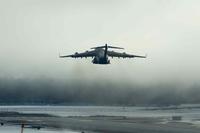It was all things Afghanistan and Pakistan at the House Armed Services Committee with lawmakers weighing the viability of a counterterrorism approach versus population centric counterinsurgency and Afghan commander Gen. Stanley McChrystal’s new strategy. An interesting aspect of this debate is the level of knowledge shown by some members of Congress on everything from the proper troop to civilian ratio called for in classic counterinsurgency doctrine to the intricacies of the Tajik versus Pashtun balance in Afghanistan.
The Obama administration has taken some serious heat in recent days for what former Vice President Dick Cheney called “dithering” over the decision to escalate in Afghanistan or not. The reliably hawkish Tom Donnelly of AEI, part of the escalate often and everywhere crowd, even provided an exhaustive timeline of the Obama administration’s “long road to indecision” that can be found here.
Two prominent retired generals Barry McCaffrey and David Barno, testifying before the HASC Oversight and Investigations Subcommittee on Thursday, both said it was important the administration take some time on this one. McCaffrey pointed to what he called one of the most “shameful” episodes in recent history when former SecDef Donald Rumsfeld claimed he was never asked for his viewpoint on invading Iraq before the war. It is important that the senior Obama administration officials take their time and think through the various options because once they decide, “they will own the decision.”
While urging full deliberation, both generals were pretty clear how they want that decision to ultimately turn out. For his part, McCaffrey favors escalation and called the over-the-horizon counterterrorism approach a “silly option.” He suggests sending 100,000 more troops, not just the 40,000 reportedly wanted by McChrystal. Promises have been made, he said, and not just at the national level when the Bush administration said the U.S. would lead an effort to rebuild Afghanistan. Young American troops on the ground in Afghanistan, waging a war for the will of the Afghan people, make promises every day that the U.S. will be there for them and protect them if they take sides against the Taliban.
McCaffrey said a tribal and ethnic war is underway for control of both Afghanistan and Pakistan and the security implications of Islamic extremists seizing power in either location are too serious not to escalate the U.S. military commitment to the region. Because of the inability of non-governmental and aid organizations to function in Afghanistan due to the security concerns, he recommended sending at least two engineering brigades and a slew of Army Corps of Engineer folks to work on large development projects.
If the military effort stumbles in Afghanistan and the U.S. were to seriously draw down there, it would likely spell the end of NATO as a military alliance, said Barno. To declare success and pull out now, would simply mean the U.S. military would be forced to re-invade the country at some future date when Islamic radicals take power in Kabul and re-establish a terrorist sanctuary there. Barno also favors an escalation of the troop commitment in Afghanistan along the lines of McChrystal’s rumored 40,000 troop request.
Many Afghans have been forced to choose a side in this war, and they have sided with the U.S. and NATO against the Taliban, said Beth Ellen Cole, of the United States Institute of Peace. A Taliban takeover could condemn many of them to a very bleak future, she said, “we have a lot of exposed people on the ground right now.” She pointed to efforts at reconstruction and peacekeeping in both Rwanda and Sierra Leone as examples that the international community can in fact improve the lot of war torn countries.







